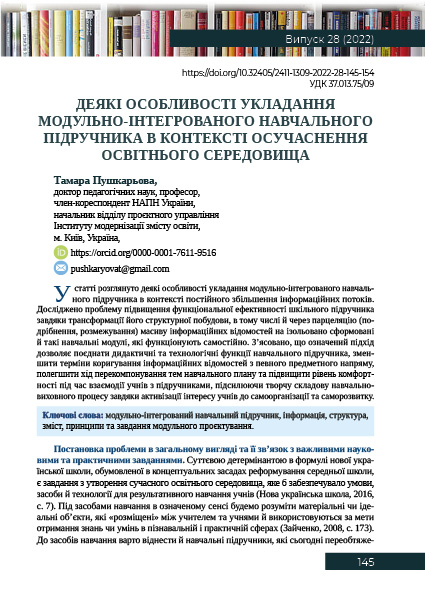Some features of compiling a modular-integrated textbook in the context of modernizing the educational environment

Published 2022-07-20
Keywords
- modular-integrated textbook,
- information,
- structure,
- content,
- principles and tasks of modular design
How to Cite

This work is licensed under a Creative Commons Attribution-NonCommercial-ShareAlike 4.0 International License.
Abstract
The article deals with some features of compiling a modular-integrated textbook in the context of a constant increase in information flows. The problem of increasing the functional efficiency of the school textbook due to the transformation of its structural structure, including through parceling (grinding, delimitation) of the array of information of the textbook into isolated and self-functioning educational modules. It was found that this approach allows to combine didactic and technological functions of the textbook, reduce the time of adjustment of information from a particular subject area, facilitate the decomposition of curriculum topics and increase comfort during interaction with students, strengthening the creative component of the educational process due to the awakening (activation) of students’ interest in self-organization and self-development.
The examination of the considerations presented in the study allows us to consider the process of compiling a modular-integrated school textbook as an active direction of modernization of the educational environment. The new Ukrainian school desperately needs such educational literature, which could perform not only the functions of an accumulator and transmitter of knowledge, but also a teacher’s assistant in the personality-oriented development of students. From the presented position, the modernized school textbook serves as an effective tool for the activity of students who position their actions with a creative and constructive approach to the educational process.
The modular-integrated model of the textbook studied in the article recognizes the individuality of students as the exclusively dominant direction in the transformation of educational space, in the coordinates of which each student is during the most important, from a pedagogical point of view, life cycle. In contrast to the classic (mass) textbook, the modular development tool allows to use it as an effective creative and technological educational tool within the walls of the educational institution, as well as in the implementation of self-taught education.
Downloads
References
- Зайченко, І.В. (2008). Педагогіка. Київ: Освіта України.
- Кодлюк, Я.П. (2014). Концептуальні основи побудови підручника для початкової школи. Проблеми сучасного підручника. 14, 284–292.
- Кодлюк, Я.П., Самотіс, М.В. (2012). Технологічність підручника для початкової школи. Проблеми сучасного підручника: 12 (2), 432–437.
- Кочерга, О.В. (2015). Чутливість у сприйманні навчальної інформації в учнів початкової школи. Іноземні мови в школах України. 1, 15–18.
- Мельничук, О.С. (ред). (1985). Словник іншомовних слів. Київ: Українська радянська енциклопедія.
- Нова українська школа. Концептуальні засади реформування середньої школи. (2016). Київ: МОН України.
- Огнев’юк, В.О. (1995). Принцип модульності в історії освіти. Київ: УІПКККО МО України.
- Пометун О.І., Гупан Н. М. (2014). Проектування шкільного підручника: вимоги і проблеми. Проблеми сучасного підручника. 14, 564–673.
- Пометун, О.І. (2016). Принципи конструювання підручника з історії з позиції системного підходу. Проблеми сучасного підручника. 17, 388–402.
- Пустовіт, Л.О. (ред). (2000). Словник іншомовних слів. Київ, Дніпро.
- Топузов, О.М. (2014). Дидактична прогностика в контексті теоретико-методичного забезпечення створення сучасного підручника. Проблеми сучасного підручника. 14, 12–20.
- Трубачева, С.Е. (2015). Шкільний підручник у компетентнісно зорієнтованому освітньому
- середовищі. Проблеми сучасного підручника. 15 (2), 300–307.
